- Home
- Jack Canfield
Chicken Soup for the Cat and Dog Lover's Soul Page 11
Chicken Soup for the Cat and Dog Lover's Soul Read online
Page 11
My husband was irked. Frank had said he’d be home all day. Maybe he’d had to give Donna a ride to work at the hospital. But my husband couldn’t wait around. He had made appointments for the rest of the day and had to get going. Something of this must have shown on his face, for the man in the next yard said, “What’s the problem, young fella?”
My husband explained his predicament and the neighbor offered to keep the puppy at his house until Frank returned. The neighbor had a fenced yard and said it’d be no trouble at all. He was a nice man with dogs of his own, and my husband decided it would be all right. He gave the puppy to the neighbor and left for his appointments.
The following Monday when I returned to work, my coworker said to me, “Did you change your mind about giving away Blue?”
Surprised, I answered, “No. Why?”
“Well, Donna told me you never delivered her on Friday. They figured you’d had a change of heart when it came time to really say good-bye.”
I told her we certainly had delivered Blue. I called Donna and told her about the neighbor taking care of Blue until Frank returned.
“But Frank was home all day!” she insisted. “And we haven’t heard from any of our neighbors.”
What on earth was going on? We finally figured out that my husband had made a wrong turn and had gone to 412 on the next street over. There had been a storm not long before and many people had ladders out to do roof and gutter repairs. Could it possibly be that the man in that house was also named Frank?
My husband and I got into the car and drove over to see what had become of Blue. We saw immediately that that he’d gone one street too far and we knocked on the door of the house where he’d left Blue.
A red-faced man in his sixties answered our knock. When we explained that we were looking for a puppy that had been delivered here last week, the man answered, “Oh, you mean the one that Frank ordered.”
Realizing that the man at 412 on this street was also named Frank, we explained the mix-up. The man’s face grew somber.
“What’s wrong?” I asked. “Is the puppy all right?”
“Oh, the puppy is fine. In fact, I’m sure the puppy is great. But . . . well, I hope you don’t want it back,” he said seriously. Seeing the question in our eyes, he continued, “When you came with the puppy on Friday, my neighbor Frank was at the hospital. He’d been out in the yard working and had started having chest pains, so his wife took him to the hospital. Frank never did come home. He died of a massive coronary Friday afternoon. It was a terrible shock for his family, and I decided not to bother them until things had settled down a bit. Yesterday, I brought the puppy over and knocked on their door. Frank’s eldest daughter came out. I told her that her father had ordered a puppy and since he hadn’t been home, that I’d taken delivery on it for him. I said I didn’t know what to do with the little dog now that ‘things had changed’ at their house.
“The daughter just couldn’t believe it. She said, ‘My father ordered a puppy? This is Dad’s puppy?’ Then she reached out and I gave her the pup. She hugged that little dog real tight, stuck her face in its fur and just began to cry.
“I wasn’t sure what to say, so I just stood there. After a while, she looked up at me and thanked me. She said, ‘You don’t know what this means to me. I’m so glad to have my father’s dog.’ The puppy was wiggling around, trying to kiss the daughter any way it could and her face was just lit up with love.”
Amazed at the story I turned to my husband, “We can’t take Blue back now.”
The man nodded in agreement. “Folks, some things are just meant to be. I’d say that puppy is in exactly the right place.”
Cindy Midgette
Is Holly Working Today?
For Holly and me, it started with a stray kitten. Abandoned in the harsh winter weather, she huddled in a ball on the front steps of our building, an elementary school for emotionally disturbed children where I provided therapy three days a week.
That morning, I kept the kitten in my office while the principal figured out where to take it. Little did I know that this tiny bundle of fur curled next to my desk would inspire a project that would affect the entire well-being of the school.
It started as the children soberly traipsed into my office that day for their therapy. When they spotted the kitten, their faces suddenly brightened. Their reticence and tenseness seemed to melt away as they petted the stray, and our sessions were relaxed and open. The kitten’s effect was astounding, and, by the end of the day, I was hatching a plan. My dog, Holly, was a gentle, gregarious, well-behaved seven-year-old of mixed parentage. Couldn’t she have the same relaxing effect on the children I counseled? The more I thought about it, the more I was convinced that Holly was perfect for the job. She loved to ride in the car, could follow basic commands in English and Spanish, and could tolerate small, sticky hands running their fingers through her short, brown hair. Enthused, I began paperwork requesting permission to bring Holly to school with me, providing documentation of the benefits of companion animals.
The enthusiasm stopped short at my supervisor’s desk. “What if it bit one of the children? What if it had an accident?” she asked me curtly. Obviously skeptical, she pushed my proposal through the proper channels. The project was approved, but my supervisor clearly let me know that Holly and I were on trial. The responsibility for any problems with the “dog experiment” would land squarely on my shoulders.
Optimistic nonetheless, I smiled at the signs pasted on my office door as I unlocked it on Holly’s first morning with me at school. “Holly is happy to be here,” the children had carefully stenciled. Already the children were responding positively to the idea of a dog counselor. Holly sniffed out my office, and we settled in for a day of work.
At a knock on my door, Holly jumped up and barked loudly. I hurried to calm her down, wincing at the noise; I was sure my supervisor would not consider the barking therapeutically productive for insecure children. We would have to work on that. A small boy entered, and he and Holly stared at each other warily.
“Does that dog bite?” he asked.
“No,” I assured him. “Why don’t you give her a treat?” I handed him a bag of multicolored doggie treats. “Pick any color you like,” I said. The boy chose a red treat and tentatively held it out to Holly. She neatly and gently took the treat, swallowed it quickly and licked the boy’s hand. The boy smiled. Holly’s critical debut had been a success.
After the bell rang, a succession of little visitors came to our door, vying to see Holly. As they took turns handing treats to Holly, she wagged her tail and licked their hands, showing her approval. It was no wonder the children were drawn to her: For many of them, it was their first encounter with unconditional acceptance.
During the days that followed, Holly learned not to bark at the children’s knocks on my office door. I set up a corner for her in my office on a piece of carpet remnant. The children eagerly came to me for their counseling visits, sitting on the floor by Holly and petting, brushing, playing with and confiding in her. As they relaxed with Holly, they let down their defenses. Our counseling sessions became smooth and productive.
Little by little, Holly’s influence reached beyond her little corner of my office. Absences at school began to drop, and the children’s disruptive behaviors softened. Even the teachers ducked in for some pet therapy throughout the day, giving Holly a short pat and restoring their spirits in her presence.
I didn’t realize how loved Holly was, though, until I missed two days of work with strep throat. When I called in sick the first day, expecting a touch of sympathy, I was immediately asked if that meant Holly would have to stay home, too. The second day, I was seriously asked if I could at least send Holly to work in a cab. Apparently, the teachers were tired of answering the question: “Is Holly working today?”
One morning before school, nine-year-old LeMar, a third-grader who visited Holly regularly, was shot and killed in a domestic dispute. His classmates learned
of the tragedy while they were still on the school bus, and by the time they arrived at school, they were terrified and in tears.
I hurried to LeMar’s home classroom, Holly trailing behind me. LeMar’s teacher stood there with tears streaming down her face. “My degree didn’t prepare me to handle something like this,” she sobbed. I mustered all my resources and expertise to come up with the right words to soothe them.
“Crying is okay for adults and children,” I began, “especially when something like this happens.” Still seeing the pain on their faces, I continued to tell them that it was okay to be scared, that fear is a natural response. For a while, we talked about how we would miss LeMar. It was at this point that I realized what Holly was doing.
She was working her way around the room, going from child to child—and the teacher—putting her front paws on their laps and stretching up to lick the tears from their faces. Unconsciously, the children hugged her back, running their fingers through her fur with such intensity that she would have gone bald if they’d done it all day. She called no significant attention to herself, but quietly expressed love and consolation. She diligently kept up her silent comfort throughout that long, difficult day.
As I slid into the front seat of my car that afternoon, I leaned back, exhausted from the emotional trauma. I just wanted to be home. Glancing briefly into the backseat, I was surprised to see that Holly had already fallen asleep. She was just as drained as I was, if not more so, and, not for the first time, I felt a pang of guilt. Was it fair to ask my dog to take on the emotional responsibilities of troubled children? Shouldn’t she be allowed to stay home and enjoy the carefree life of a house pet?
Those doubts may be why, even now, I occasionally stop in my rush to leave for school in the morning and, instead of ordering Holly into the car, look at her, asking, “Do you want to go to school today?” When she leaps up eagerly, all wags and excitement, I figure she’s answered that burning question for all of us. Yes, Holly is working today.
Barbara J. Wood
The Healing Touch
As a veterinarian making the journey from physical medicine to spiritual understanding, I found it was the animals who were my greatest teachers. I owe an especially large debt of thanks to an old gray tabby who was once brought into my practice for treatment.
The old tabby’s pelvis was fractured so badly he couldn’t stand. He had been sideswiped by a car, but luckily his fractures were such that they would heal naturally over time without an operation. Although he didn’t appear to have any other injuries, it was critical that I keep him in the clinic for a few days just to be sure there was nothing else wrong.
“You don’t understand,” his owner said pleadingly. “This cat is seventeen, and I have another one just like him at home. They were littermates, and they’ve never been apart a day in their lives. You’ve got to let me bring him home.”
There was no way I could release the cat, no matter how emotionally wrenching the separation might be. Until he was able to stand and had bladder and bowel control, I had no choice but to keep him under observation.
“I’m sorry,” I said. “It’s best for the cat if he stays.”
By the next morning, I wasn’t so sure. The tabby gazed into space with such a vacant look in his eye that it seemed he had already given up and died. His vital signs were normal, but there was no life in him. He didn’t meow.
He didn’t purr. He just lay there without eating, staring into some distant place where all hope was extinguished.
As I pondered what to do next, the phone rang. It was the tabby’s owner, and he was frantic. “My other cat’s been screaming nonstop,” he complained. “He never went to sleep—just prowled around searching and meowing. You have to do something.”
“I don’t know if it will make a difference,” I said, “but why don’t you bring the other cat here?”
The owner made it to the clinic in minutes. When he walked in with the other cat under his arm, I thought I was seeing double. The brother cat was the image of his littermate—a fluffy pearl-gray with stripes. But while his injured sibling lay in a cage torpid in depression, this one was taut with anxious energy.
The minute I opened the cage door, the healing began. The electricity between the two cats was palpable. At the sight of his brother, the ailing cat’s eyes brightened, his ears perked up and he struggled in a futile effort to get up and draw near to him.
But it was actual contact with his brother that really made the injured cat come alive. The healthy cat bounded into the cage, rushed up to his brother and, meowing with joy, began licking and sniffing him all over. With the all-important physical link reestablished, the hurt cat mewed in response, and mustering all of his strength, reciprocated by licking any part of his brother’s body that brushed by him. A leg, a tail, an ear, a shoulder—all were touched by his tongue.
The two cats couldn’t seem to get enough of each other. They kept licking and cleaning and smelling, oblivious to anything but each other. They made it clear that for the rest of the clinic stay, they would be in the cage together.
That night, I peeked into the cage and saw that the cats were still inseparable. They were huddled close together, purring in unison, as the brother cat encircled his hurt twin with the loving warmth of his body.
After about three days, the hurt cat began to display normal body functions, which suggested that he had no further significant internal injuries. By the fourth day, he was able to stand on his own, with the help of his brother. The brother nudged him with his nose a few times, and the injured cat got the message. Haltingly, he struggled to his feet, leaning briefly against his brother for support. A few seconds later, he stood proudly on his own and took a few wobbly steps.
The next day, they went home. I didn’t see them again until two years later, when they came in for a checkup. By then, they were nineteen and still in good health. The injured cat had fully recovered and never showed any ill effects of the accident.
It was clear that the old gray tabby’s recovery resulted not from some medical breakthrough or traditional veterinary science, but from the tender touch of a brother—a profound caring that had been transferred from one to the other through the touch of a tongue and the contact of warm fur. It was these physical acts of love that had brought the gift of life.
Allen M. Schoen, D.V.M.
The Language of the Heart
Soapy Smith is a twenty-four-pound calico rex rabbit. A rex rabbit’s coat lacks the stiff guard hairs of other breeds, resulting in a fur texture that is as soft as a cloud. People look startled when they first touch him and remark how soft he is. I’ve noticed he seems to make everyone who meets him a little softer, too.
One day, Soapy Smith and I visited a shelter for battered women located in a bedraggled section of the city. The women in the shelter looked at me through downcast eyes. No one smiled a greeting, and they appeared uninterested in Soapy’s carrier. Everyone seemed tense and ready to flee. One little girl in particular moved like a wisp in the background. Never raising her eyes, never reaching out, she drifted in and out of the gathered group. The staff informed me that she had been there for over a month and had not spoken the entire time. Nothing they tried had any effect. Her mother said she had talked at one time but not in recent memory. I didn’t want to imagine what could have happened to rob this little girl of the natural curiosity and enthusiasm so natural to childhood.
Spreading a blanket on the floor, I sat down and opened Soapy’s carrier. As the silent child circled past me, I told the group that Soapy would come to talk to them if they sat on his blanket. Several children did this, including the silent girl. In a short time, Soapy emerged from his carrier and slowly hopped from one child to another. Unlike visits at schools where the first touches produced squeals of delight, this visit was unusually quiet. After touching Soapy, these children looked down and sighed softly or smiled into their hands. Soapy continued his rounds, and the children and their mothers gradually began to t
alk about Soapy and ask questions.
I chatted with the women and children as I kept one eye on the little girl. She sat rigidly at the edge of the blanket, legs held stiffly out straight in front of her. She was staring hard at Soapy. It appeared that he kept making eye contact with her. He would hop from child to child, each visit taking him a little closer to the girl. I began to wonder if he was pausing to give her time to watch him. During all other visits we had given together in schools, his usual behavior was to hop around the circle letting each person pet him. When he got back to me he would wash his face and then start the circle again.
That day, I watched as Soapy finally worked his way toward the girl. She didn’t reach out to him or encourage him in any way. Rather she sat tensely, just staring.
Finally Soapy came to a stop about two inches from her thigh. He quietly reached out and laid his chin on her knee. I was astonished. While a common behavior for dogs, this is not a behavior exhibited by rabbits, especially not by this rabbit.
The child did not reach out to pet Soapy. Instead, she slowly leaned toward him. When her face was within inches of his, she carefully reached out and circled him with her arms. So softly that no one in the room could hear, she began to talk. Folded around the rabbit, she pillowed her head on his back and whispered to him. Soapy remained motionless.
I looked up and noticed that the shelter workers had stopped talking. Every adult in the room froze in place. Time seemed suspended. Then quietly the child unfolded and sat back up. Soapy sat up too, reached forward and briskly licked her knee. She did not smile. She did not reach out to him, but the rigidity of her back relaxed, and her shoulders rounded into a comfortable slope. The little girl stood up and walked over to her mother and began to suck her thumb.
The little girl reappeared when I was preparing to leave. She reached her hands out and looked me directly in the eye. I held Soapy out to her. She wrapped him in a big hug and pressed her face against him. Suspended from my hands as he was, I was concerned that he would begin to struggle. Instead he reached out his head again and laid it on the child’s shoulder. His breathing slowed and he closed his eyes. As quickly as it happened, the little girl released her hug and stepped back. As she turned away, I thought I saw the beginnings of a faint smile.

 Chicken Soup for the Nurse's Soul: Second Dose
Chicken Soup for the Nurse's Soul: Second Dose Chicken Soup for the Ocean Lover's Soul
Chicken Soup for the Ocean Lover's Soul A 2nd Helping of Chicken Soup for the Soul
A 2nd Helping of Chicken Soup for the Soul Chicken Soup for the Nurse's Soul
Chicken Soup for the Nurse's Soul Chicken Soup for the Breast Cancer Survivor's Soul
Chicken Soup for the Breast Cancer Survivor's Soul Chicken Soup for the Pet Lover's Soul
Chicken Soup for the Pet Lover's Soul Chicken Soup for the Bride's Soul
Chicken Soup for the Bride's Soul A Chicken Soup for the Soul Christmas
A Chicken Soup for the Soul Christmas Chicken Soup for the Soul of America
Chicken Soup for the Soul of America Chicken Soup for the Teenage Soul on Tough Stuff
Chicken Soup for the Teenage Soul on Tough Stuff A Taste of Chicken Soup for the Teenage Soul III
A Taste of Chicken Soup for the Teenage Soul III Chicken Soup for Every Mom's Soul
Chicken Soup for Every Mom's Soul Chicken Soup for the Dog Lover's Soul
Chicken Soup for the Dog Lover's Soul A Second Chicken Soup for the Woman's Soul
A Second Chicken Soup for the Woman's Soul Chicken Soup for the Soul the Book of Christmas Virtues
Chicken Soup for the Soul the Book of Christmas Virtues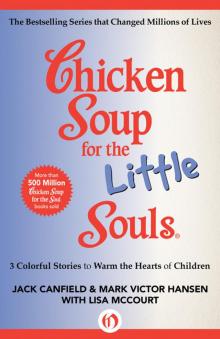 Chicken Soup for the Little Souls: 3 Colorful Stories to Warm the Hearts of Children
Chicken Soup for the Little Souls: 3 Colorful Stories to Warm the Hearts of Children Chicken Soup for the African American Woman's Soul
Chicken Soup for the African American Woman's Soul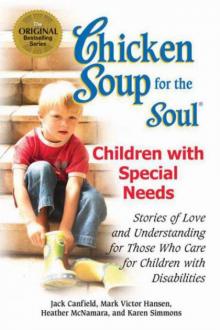 Chicken Soup for the Soul
Chicken Soup for the Soul Chicken Soup for the Soul Celebrates Teachers
Chicken Soup for the Soul Celebrates Teachers Chicken Soup for the College Soul
Chicken Soup for the College Soul Chicken Soup for the Recovering Soul Daily Inspirations
Chicken Soup for the Recovering Soul Daily Inspirations Chicken Soup for the Soul Celebrates Sisters
Chicken Soup for the Soul Celebrates Sisters Chicken Soup for the Dieter's Soul
Chicken Soup for the Dieter's Soul Chicken Soup for the Soul at Work 101 Stories of Courage
Chicken Soup for the Soul at Work 101 Stories of Courage Chicken Soup for the Beach Lover's Soul
Chicken Soup for the Beach Lover's Soul Stories About Facing Challenges, Realizing Dreams and Making a Difference
Stories About Facing Challenges, Realizing Dreams and Making a Difference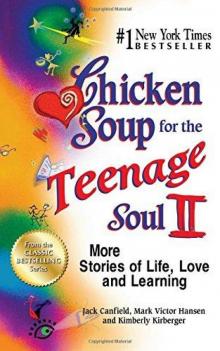 Chicken Soup for the Teenage Soul II
Chicken Soup for the Teenage Soul II Chicken Soup for the Girl's Soul
Chicken Soup for the Girl's Soul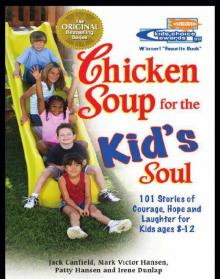 Chicken Soup for the Kid's Soul: 101 Stories of Courage, Hope and Laughter
Chicken Soup for the Kid's Soul: 101 Stories of Courage, Hope and Laughter Chicken Soup for the Woman's Soul
Chicken Soup for the Woman's Soul Chicken Soup for the Cancer Survivor's Soul
Chicken Soup for the Cancer Survivor's Soul Chicken Soup for the Canadian Soul
Chicken Soup for the Canadian Soul Chicken Soup for the Military Wife's Soul
Chicken Soup for the Military Wife's Soul A 4th Course of Chicken Soup for the Soul
A 4th Course of Chicken Soup for the Soul Chicken Soup Unsinkable Soul
Chicken Soup Unsinkable Soul Chicken Soup for the Soul: Christmas Magic
Chicken Soup for the Soul: Christmas Magic Chicken Soup for the Grandma's Soul
Chicken Soup for the Grandma's Soul Chicken Soup for the Soul: All Your Favorite Original Stories
Chicken Soup for the Soul: All Your Favorite Original Stories Chicken Soup for the Expectant Mother's Soul
Chicken Soup for the Expectant Mother's Soul Chicken Soup for the African American Soul
Chicken Soup for the African American Soul 101 Stories of Changes, Choices and Growing Up for Kids Ages 9-13
101 Stories of Changes, Choices and Growing Up for Kids Ages 9-13 Christmas Magic
Christmas Magic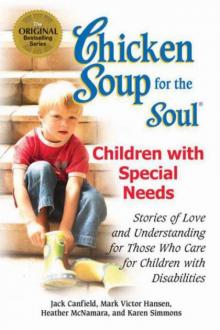 Chicken Soup for the Soul: Children with Special Needs
Chicken Soup for the Soul: Children with Special Needs Chicken Soup for the Soul: Country Music: The Inspirational Stories behind 101 of Your Favorite Country Songs
Chicken Soup for the Soul: Country Music: The Inspirational Stories behind 101 of Your Favorite Country Songs Chicken Soup for the Country Soul
Chicken Soup for the Country Soul Chicken Soup for the Recovering Soul Daily Inspirations (Chicken Soup for the Soul)
Chicken Soup for the Recovering Soul Daily Inspirations (Chicken Soup for the Soul) A 3rd Serving of Chicken Soup for the Soul
A 3rd Serving of Chicken Soup for the Soul The Book of Christmas Virtues
The Book of Christmas Virtues Chicken Soup for the Soul at Work
Chicken Soup for the Soul at Work Chicken Soup for the Soul 20th Anniversary Edition
Chicken Soup for the Soul 20th Anniversary Edition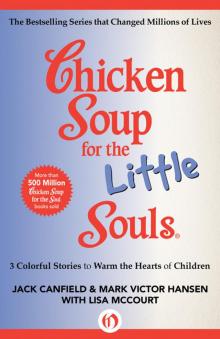 Chicken Soup for the Little Souls
Chicken Soup for the Little Souls Chicken Soup for the Soul: Reader's Choice 20th Anniversary Edition
Chicken Soup for the Soul: Reader's Choice 20th Anniversary Edition Chicken Soup for the Soul Christmas
Chicken Soup for the Soul Christmas Taste of Chicken Soup for the Teenage Soul III
Taste of Chicken Soup for the Teenage Soul III Chicken Soup for the Unsinkable Soul
Chicken Soup for the Unsinkable Soul Chicken Soup for the Preteen Soul II
Chicken Soup for the Preteen Soul II